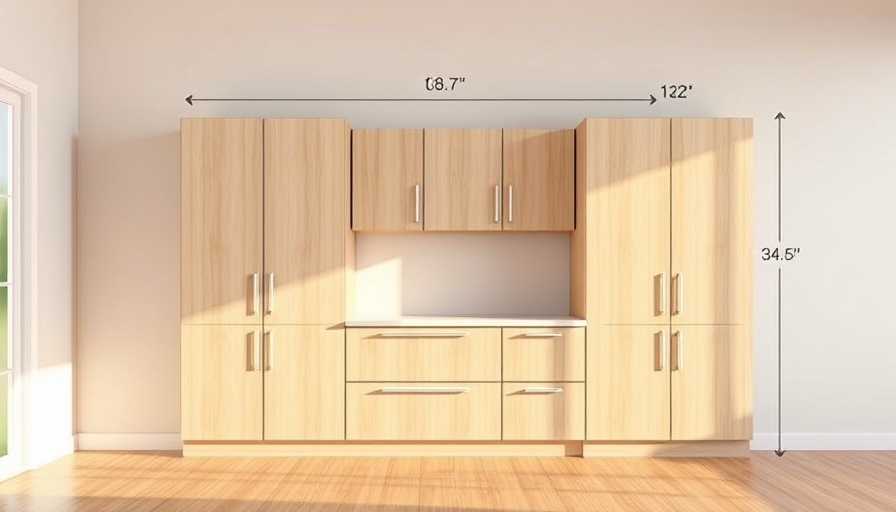
Understanding Standard Kitchen Cabinet Dimensions: Why It Matters
Renovating a kitchen is an exciting venture, but ensuring that everything fits perfectly — from cabinets to appliances — can be a daunting task. Standard kitchen cabinet dimensions provide a framework that simplifies this process. Knowledge about these dimensions not only aids in planning but also ensures functional use of space in both small and large kitchens. For homeowners and designers alike, familiarizing oneself with cabinet sizes is a vital step that can maximize aesthetics and organization in the kitchen.
Exploring the Standard Sizes of Kitchen Cabinets
Kitchen cabinets come in a variety of standard sizes designed to accommodate different needs and preferences. Here's a detailed look at the common dimensions:
- Base Cabinets: Typically, base cabinets stand at 34.5 inches high, adding up to 36 inches with a countertop. They usually have a depth of 24 inches, although 21 inches can be utilized in compact kitchens. Their widths vary widely from 12 to 48 inches.
- Wall Cabinets: Wall cabinets are available in heights of 30, 36, or 42 inches, commonly with a depth of 12 inches. The widths range anywhere from 12 to 36 inches, installed typically 18 inches above the countertop.
- Tall Cabinets: Designed for pantries or storage, tall cabinets typically measure 84, 90, or 96 inches in height, with a depth of 24 inches, or 12 inches for narrower options, while widths include a variety up to 36 inches.
- Oven Cabinets: These cabinets are customized to fit built-in appliances, usually standing at 27 to 29 inches in height, 22 to 24 inches deep, and available in widths from 24 to 33 inches.
Measuring Your Kitchen Accurately
Proper measurement is essential for a seamless fit. Start by measuring the exterior width, depth, and height of each cabinet while adding 1 inch for box thickness and half an inch for the hinge clearance. Furthermore, ensure adequate spacing between cabinets and kitchen islands, ideally around 40 inches, to promote ease of movement.
The Benefits of Standardized Dimensions
Standard kitchen cabinet dimensions not only simplify the design process but also enhance functionality. Cabinets that adhere to set sizes ensure compatibility with appliances and can be ergonomically aligned for comfort and practicality. This allows homeowners to make informed choices, optimizing the layout to suit their cooking habits and family dynamics.
Design Trends to Watch: Customization vs. Standardization
While standard dimensions provide a solid base for kitchen designs, customization is increasingly popular for those looking to create unique spaces. Tailoring cabinet sizes can address specific architectural challenges or personal preferences. However, understanding standard sizes still serves as a valuable reference point as it allows for better planning and execution of custom projects.
Current Trends in Kitchen Design That Influences Cabinet Choices
Modern kitchen design trends also play into the importance of cabinet dimensions. Open-concept layouts often require cabinets that maximize storage while maintaining a sleek aesthetic. Designers aim for a balance where functionality meets style, utilizing standard dimensions as a leap-off point before customizing. Features such as pull-out shelves and deeper upper cabinets are gaining popularity as they facilitate access and increase capacity.
Practical Insights for Homeowners
Homeowners embarking on kitchen renovations should prioritize understanding standard kitchen cabinet dimensions. Knowing these dimensions will eliminate guesswork and ensure that your dream kitchen transforms seamlessly from plan to reality. Always consider how you use your kitchen space and select cabinet styles that enhance functionality.
Conclusion: Making Informed Kitchen Design Choices
A well-planned kitchen design, built upon standard cabinet dimensions, can lead to an efficiently functional and visually appealing space. As kitchen trends evolve, staying informed about standard sizes will assist homeowners in making informed decisions, paving the way for kitchen designs that cater to both aesthetic desires and practical needs.
 Add Row
Add Row  Add
Add 



 Add Row
Add Row  Add
Add 
Write A Comment